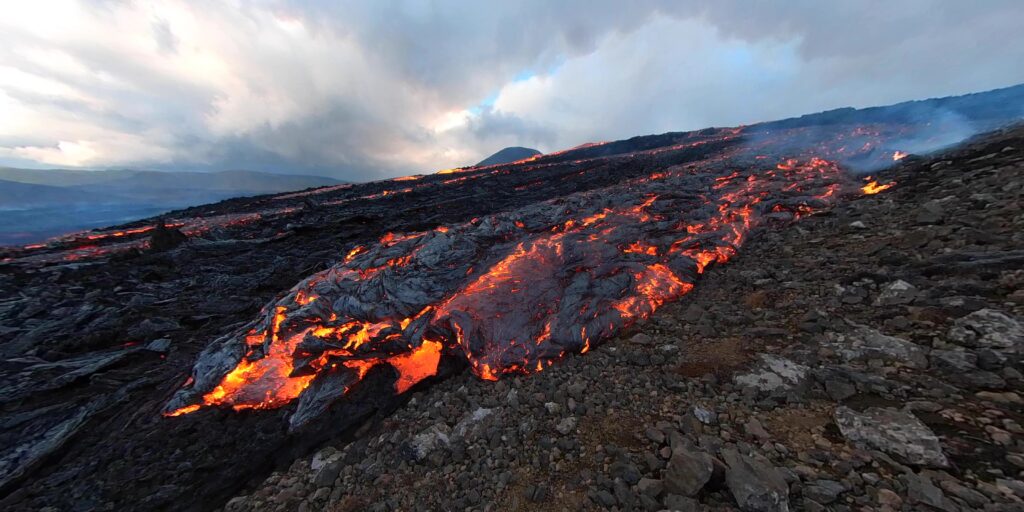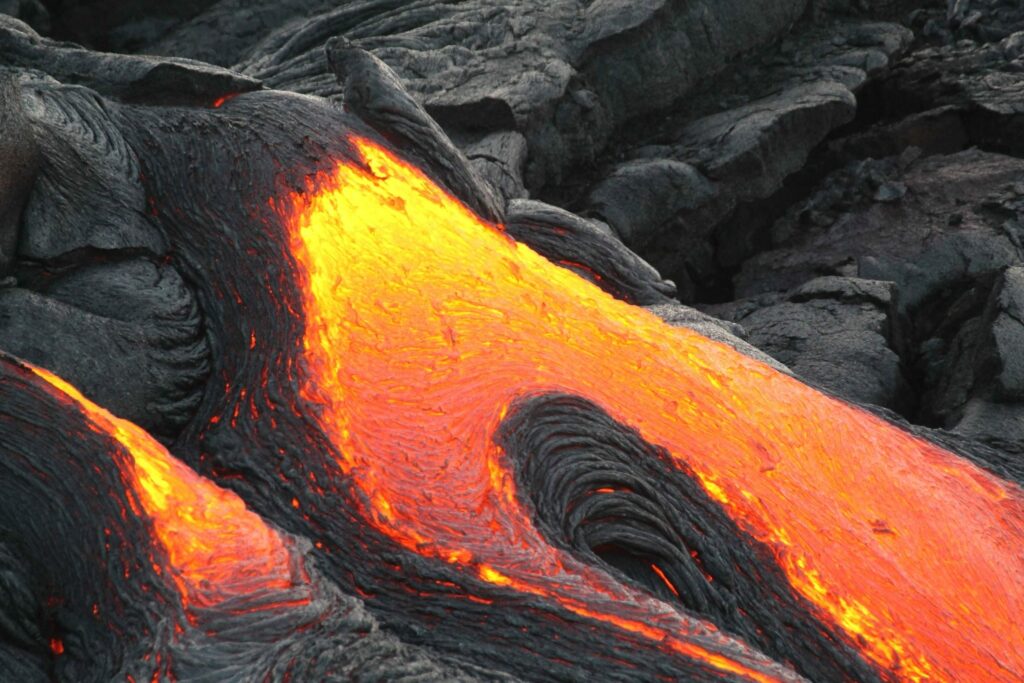In early 2021, much of the world was locked in pandemic mode, but beneath Iceland’s southwestern Reykjanes Peninsula, nature was preparing to put on a show. On 19 March, a long-dormant volcano called Fagradalsfjall began expelling fiery lava from freshly fissured Earth against a backdrop of low hills surrounding the Geldingadalur valley.
More than 2,000 kilometers away, Maren Kahl, a researcher at Universität Heidelberg in Germany, was receiving eruption updates from colleagues whom she knew from her time as a postdoctoral fellow at the University of Iceland. Limited by pandemic restrictions, Kahl could not see the Fagradalsfjall spectacle in person, so she asked her colleagues to save her samples of Iceland’s newest rocks.
As detailed in Kahl and colleagues’ recently published Geology paper, individual crystals within these rocks revealed when magmatic unrest began and how the Fagradalsfjall eruption evolved. The event was the first well-monitored eruption that ultimately spouted melted rock sourced directly from Earth’s mantle.

A Sea of Crystal Mush
Many scientists suspect that magma chambers, contrary to popular perception, are not underground reservoirs of melted rock. Instead, Kahl explained, they can be thought of as crystal mushes—networks of interlocking crystals hosting horizons of melt. Minerals slowly grow as the surrounding melt solidifies in layers, like rolling snowballs.
If the magma composition in the mush remains the same through time, the chemical makeup of a growing crystal will be uniform. If new magma enters, it brings its own unique composition, along with heat that helps “unlock” crystals from the mush. As the unlocked crystals are incorporated into the new melt, they each can grow a compositionally distinct layer. If this melt remains at depth, heat from the fresh magma causes the initially sharp boundary between layers to blur as elements diffuse through the crystal. The longer a crystal stews in magma, the blurrier the boundaries between layers become.
When a volcano erupts, the layers in the expelled crystals are frozen by the rapid decrease in temperature, said Kahl. She and her coauthors extracted single crystals from the Fagradalsfjall rocks and, after mounting them in epoxy, polished them to expose their interiors. Measuring compositional changes from edge to core allowed the researchers to calculate how blurry the boundaries were and therefore, the duration of time that new magma spent interacting with the crystal before eruption.
Priming, Run-Up, Eruption

The calculated durations ranged from years to days, which, along with other data, allowed the researchers to assign different phases to Fagradalsfjall’s unrest.
The longest durations that crystals spent interacting with new magma extended to several years before any geophysical signals hinted at an impending eruption. During this “priming” phase, magma stealthily accumulated near the boundary between crust and mantle, unlocking the mush. In this region, called the Mohorovičić discontinuity—about 15–20 kilometers (9–12 miles) deep in this part of Iceland—rocks tend to flow instead of break. For this reason, the earliest and deepest stirrings of magma were undetectable by the seismometers installed on the Reykjanes Peninsula at that time.
About a year before the eruption, a transition phase commenced, marked by increased shallow seismicity in the region and somewhat shorter durations from the crystals. Near Fagradalsfjall, scientists detected earthquakes at depths of around 10–12 kilometers (6–7 miles), but these events were small and difficult to detect, explained Kahl. These seismic signals could indicate that either magma or carbon dioxide–rich fluids were moving from deep storage into the shallow crust, about 4–7 kilometers (2–4 miles) below the surface.
Continued escalation of geophysical signals and shortening of the durations that crystals spent interacting with new magma marked an acute run-up phase, which began about a month before the eruption.
Three days prior to the eruption, two clusters of seismicity concentrated just beneath the eventual eruption site. The high rates of seismicity and deformation seen in the acute run-up phase ceased. Samples collected from 20 to 23 March 2021—the eruption’s early days—confirmed that magma stalled near the surface, said Kahl.
Crystals within samples collected during April and May of 2021, after the eruption began, tended to yield much shorter durations. “That indicates that those samples were flushed directly from the deeper system,” Kahl explained. Once the plumbing had formed and belched its contents during the first few days of the eruption, the path was clear for deeper-sourced magma to ascend.
Seismic Shifts
“This is such a unique case, where [they] were able to monitor both geophysical and geochemical data throughout an eruption,” said Kristín Jónsdóttir, a seismologist at the Icelandic Met Office who was not involved with the study. The new research “helps us to interpret the whole story of what happened preceding the eruption.” This is especially important for Fagradalsfjall, which resides a mere 40 kilometers (25 miles) from Iceland’s capital, Reykjavík.
Regional seismic networks can help scientists visualize what’s happening in the brittle crust, which, in Iceland, usually extends to about 10–15 kilometers (6–9 miles) below the surface, said Jónsdóttir. Kahl and her colleagues’ diffusion data provided a hint of what seismologists could look for in detecting early, deep magma movement during future eruptions.
One limitation of detecting such deep events may be simply not enough seismic stations. “Since the unrest started on the Reykjanes Peninsula, we have added more stations, so we stand a better chance of finding these events,” Jónsdóttir explained.
“If you live in a place like Iceland,” Kahl said, “you would like to know how fast magma can travel from depth to the surface.”
This article was republished from EOS.






